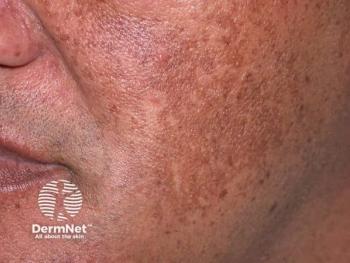
- Dermatology Times, February 2022 (Vol. 43. No. 2)
- Volume 43
- Issue 2
- Pages: 27
Experts Tackle Skin-Lightening Controversy
Unsafe and toxic skin-whitening products continue to draw fire.
Melasma is much more than a cosmetic complaint, said Seemal R. Desai, MD, FAAD, a clinical assistant professor in the Department of Dermatology at UT Southwestern Medical Center in Dallas, Texas, during the Skin of Color Society’s Virtual Media Day, held November 9, 2021. Instead, he emphasized the chronic nature and acute psychological impact of melasma.
The characteristic light brown, dark brown, and/or blue-gray patches on the skin can appear as either flat patches or frecklelike spots. Melasma usually affects the face, including the cheeks, upper lip, and forehead, as well as the forearms.1
The most common melasma triggers include:2,3
1. SUN EXPOSURE
UV light has been shown in both clinical and laboratory studies to trigger and exacerbate melasma. “UV light is thought to induce reactive oxygen species (ROS) by activating inducible nitric oxide and promoting melanogenesis,” wrote the authors of a study published in Dermatology and Therapy.3 “Patients with melasma have also been found to have higher markers of oxidative stress. A seminal study showed sustained pigmentation from visible light in darker skin types over 2 weeks compared to pigmentation from UVA-1 light. The authors also highlighted their finding that keratinocytes and fibroblasts can stimulate the process of melanogenesis after UV and visible light exposure. “One major pathway of both UV- and visible light–induced pigmentation is the secretion of stem cell factor (SCF), the ligand for the tyrosine kinase receptor, c-kit, which leads to downstream effects on the proliferation of melanocytes,” the authors wrote.
2. HORMONE CHANGES
The skin disorder is also referred to as the “mask of pregnancy.” Data show that 15% to 50% of pregnant people present with melasma, according to Cleveland Clinic.1 Additionally, up to 33% of the overall population may get melasma in their lifetime, usually during the reproductive years but rarely during puberty.1
3. FAMILY HISTORY
This is a known risk factor—studies have reported that 55% to 64% of melasma patients have a positive family history.
4. THYROID DISEASE
Investigators have looked into an association between endocrinological conditions, such as thyroid disease, and melasma, but this area needs additional analysis and study. People with skin of color (SOC), such as those of Latin, Black, Asian, Indian, Middle Eastern, or Mediterranean descent, are more likely to present with melasma.1 The skin disorder occurs when melanocytes overproduce. Those with SOC have more active melanocytes than people with light skin, increasing the likelihood of the disorder.2
Approved treatments include hydroquinone, tretinoin, corticosteroids, and other synthetic and natural topical compounds that have shown vary- ing efficacies. Aesthetic procedures such as chemi- cal peels, microneedling, radiofrequency, and laser treatments are also used as mono- and combina- tion therapies.4 “It’s important to understand that this is a chronic condition that has relaxing epi- sodes,” said Janiene Luke, MD, an associate professor in the Department of Dermatology and residency program director at Loma Linda University in California, who spoke with Desai during the virtual Media Day panel. “Despite aesthetic procedures and medical prescriptions, this condition can flare from time to time.”
For many Asian patients, unapproved skin-bleaching creams are also a popular—and dangerous—treatment option. “There is, in my opinion, a global epidemic in skin bleaching and this desire for the skin to become white, bright, and lighter,” Desai said. “Many of these long-held beliefs for many cultures are due to decades- and century-long beliefs that have led people to continue to perpetuate the myth that lighter skin is more beautiful and more acceptable skin.” Skin-bleaching or “whitening” creams accounted for about 80% of India’s $1 billion moisturizer market in 2019. In 2020, the global market was worth $8.6 billion, with the forecast demand rising to $12.3 billion by 2027.4,5
Mercury continues to be the most dangerous ingredient that can be found in skin-lightening products. Using products containing mercury can lead to kidney damage, peripheral neuropathy, scarring, and depression, among other serious health consequences.6,7 Although some consumers are moving away from whiteners containing ingredients such as toxic mercury, whiteners marketed as natural, including glutathione, remain normalized treatments in Philippine medical spas.6 The products’ use persists even after the Food and Drug Administration (FDA) Philippines issued several warnings on the use of injectable glutathione as a skin-bleaching agent.8 “[Although] ingredients may be called natural or botanical, that does not always mean that they are safe and effective,” Desai said. “For example, patients getting IV infusions of glutathione and intravenous fluid for skin lightening has become exceedingly popular, [despite] warnings from the FDA here in the US and the FDA in the Philippines and other countries, where this is rampant. IV infusions of glutathione have [been] shown to be unsafe and cause Stevens-Johnson syndrome, sepsis, and even death in some patients.”
Desai also highlighted a specific product, previously called Fair & Lovely, which caused major controversy after 2020’s civil unrest and Black Lives Matter protests in the United States. “The name alone tells you [that] the fairer your skin, the lovelier,” he said. “But the picture on the product is of a darker-skinned Indian or Asian woman becoming lighter and brighter after using this product. Because of the tragedies of 2020, Unilever actually received an immense amount of backlash for this product.9 The name has been switched to Glow & Lovely.”
References
- Melasma. Cleveland Clinic. Accessed January 7, 2022.
https://my.clevelandclinic.org/health/diseases/21454-melasma - Melasma: who gets and causes. American Academy of Dermatology Association. Accessed January 7, 2022.
https://www.aad.org/public/diseases/a-z/melasma-causes - Ogbechie-Godec OA, Elbuluk N. Melasma: an up-to-date comprehensive review. Dermatol Ther (Heidelb). 2017;7(3):305-318.doi:10.1007/s13555-017-0194-1
- Chuwirch P, Makol MK, Saxena R. Skin-whitening products are still big business in Asia. Bloomberg Businessweek. September 22, 2021. Accessed January 7, 2022.
https://www.bloomberg.com/news/articles/2021-09-22/skin-whitening-creams-remain-big-business-in-asia-despite-purge - Skin lighteners: global market trajectory & analytics. StrategyR. Accessed January 7, 2022.
https://www.strategyr.com/market-report-skin-lighteners-forecasts-global-industry-analysts-inc.asp - Mercury poisoning linked to skin products. US Food and Drug Administration. Updated November 23, 2021. Accessed January 7, 2022.
https://www.fda.gov/consumers/consumer-updates/mercury-poisoning-linked-skin-products - Araneta P. The dark side of skin lightening. Elle Canada. October 22, 2021. Accessed January 7, 2022.
https://www.ellecanada.com/beauty/skincare/the-dark-side-of-skin-lightening - Unsafe use of glutathione as skin lightening agent. Food and Drug Administration Philippines.July 5, 2019. Accessed January 7, 2022.
https://www.fda.gov.ph/wp-content/uploads/2019/07/FDA-Advisory-No.2019-182.pdf - Unilever evolves skin care portfolio to embrace a more inclusive vision of beauty. Unilever. Press release. Published June 24, 2020. Accessed January 7, 2022.
https://www.unilever.com/news/press-and-media/press-releases/2020/unilever-evolves-skin-care-portfolio-to-embrace-a-more-inclusive-vision-of-beauty/
Articles in this issue
almost 4 years ago
HS Steps Into Innovation Spotlightalmost 4 years ago
Essential Treatment Tips for Textured Hairalmost 4 years ago
Experts Weigh in on Best Body-Focused Skin Carealmost 4 years ago
How to Explain JAK Inhibitor Warnings to Patientsalmost 4 years ago
Get to the Roots of Pediatric Acnealmost 4 years ago
Legal and Tax Options for a Practice’s Structurealmost 4 years ago
Cosmetic Conundrums & Cleansing Complexitiesalmost 4 years ago
OSHA, the Needle, and the Finealmost 4 years ago
What You Need to Know About Mentoring Doctorsalmost 4 years ago
Trending Now: Pipeline Possibilities for Pediatric Skin ConditionsNewsletter
Like what you’re reading? Subscribe to Dermatology Times for weekly updates on therapies, innovations, and real-world practice tips.
















